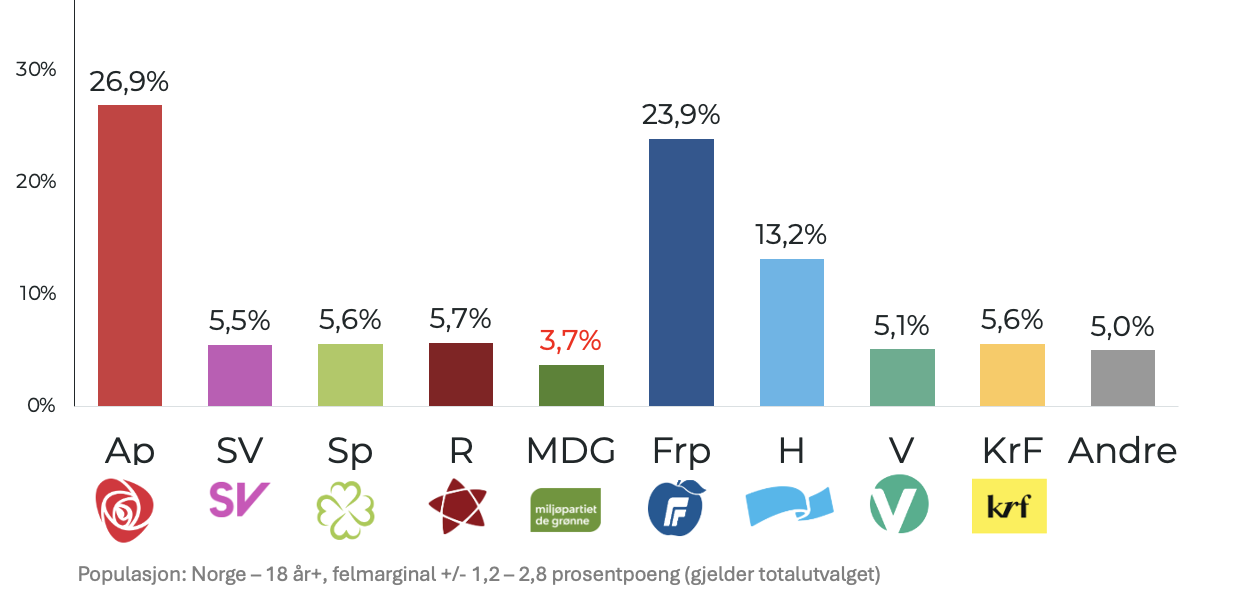How should we really interpret opinion polls in the final stretch of the campaign?
For me, it’s about separating noise from signal – and explaining why the numbers look the way they do. When we at InFact follow the election campaign, we try to step into the voters’ shoes: What have they noticed over the past week, and what feels important right now? We’re approaching election day on September 8, early voting is well underway, and the shifts are real.
August party poll – Conducted by InFact/Nettavisen on August 12 (n=1,142, IVR)

13th of August – This poll shows a narrow conservative majority because both V and KrF are above the 4% threshold.
July party poll – Conducted by InFact/Nettavisen on July 1 (n=1,115, IVR)

2nd of July – Here, the mandate map tips toward the red-green side, since KrF falls below the 4% threshold.
June party poll – Conducted by InFact/Nettavisen on June 3 (n=1 076, IVR)

4th of June – Slight conservative advantage again – because both KrF and V are just above the threshold.
What does this mean in practice?
Some clear patterns have been widely discussed in the media: Labour (Ap) remains steady, the Progress Party (Frp) has polled high and stable until recent surveys, and the Conservatives (Høyre) have faced headwinds in recent months. But the centre-right’s position above the threshold (KrF and V) is what determines block balance from week to week. Small decimals around 4% shift many mandates and make this a threshold election.
Why polls “diverge”
- Method and speed: InFact uses fully automated telephone interviews (IVR). The advantage during the final stretch of a campaign is speed – short field periods link movements to concrete events and reduce “time noise”.
- Threshold dynamics: Just 0.3–0.5 percentage points around the 4% line can tip 6–12 seats – which is why headlines may shift even if the main barometer barely moves.
Early voting: what it means for interpretation
Early voting is high this year, and signs point to a record share casting early ballots. This means more voters “locked in” their choice earlier – and that the last-minute shifts in the agenda primarily affect those who haven’t yet voted. In the final phase, the focus is more about mobilising the rest than persuading large groups to switch sides.

Undecided voters on the move – what do we know (and what don’t we)?
I’m cautious about drawing firm conclusions. But based on several recent polls and analyses, I believe we can confidently say:
- Voter loyalty appears to be increasing for both Labour (Ap) and the Conservatives (Høyre), according to the latest poll averages from Poll of Polls and a recent survey by Respons – meaning more “former voters” are returning in the final stretch.
- Frp is showing signs of slowing in some new polls. That may be temporary – but it makes it easier for both Ap and Høyre to win back undecided voters.
- Issue ownership is key: Polls on “who has the best policies on…” suggest that Høyre is not currently owning many winning issues. At the same time, voters still perceive the conservative bloc as stronger on the economy and employment. Where the fence-sitters land depends on which issues dominate the agenda day-to-day.
In other words: there’s movement among undecided voters – but the direction is shaped by agenda and mobilisation, and small shifts may fall within the margin of error. That’s why I focus more on trends across multiple polls than on individual peaks.
In short – my current interpretation:
- Labour (Ap) is steady, Frp is polling high, Høyre faces headwinds – but the position of V and KrF around the threshold determines block balance week by week.
- Small changes may fall within the margin of error – so focus on trends, mandates and field periods in combination.
- Early voting makes the fight for the undecided more targeted and practical – it’s about “getting them to the ballot box”.
Election day is September 8 (several municipalities also allow voting on Sunday, September 7). Happy voting to you all!
Want to better understand what opinion polls are really saying – and how to use them to make better decisions?
At InFact, we help both public and private organisations interpret data, identify patterns, and act on insight.
Feel free to reach out – I’d be happy to share more.
Per Rusten
Senior Analyst at InFact
per@infact.no

Sources:Valgdirektoratet (updated 27.08) on early voting, Aftenposten/Respons and VG/Respons on loyalty and the Frp decline, Nettavisen/InFact on economic perception, Poll of Polls on August averages and threshold effects.
